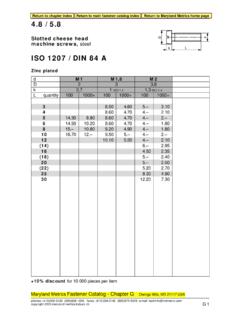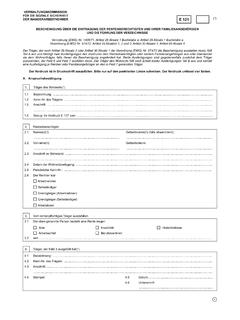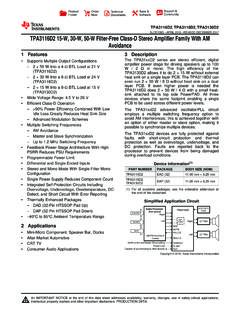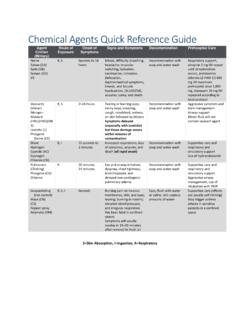Transcription of Methamphetamine use in Australia
1 Methamphetamine use in Australia Ann Roche, Alice McEntee, Jane Fischer, & Victoria Kostadinov There is growing concern about Methamphetamine use in Australia . This document provides an overview of current patterns and trends in Methamphetamine use and associated harms in Australia , with a particular focus on ice. For more information and resources visit the NCETA website: National Centre for Education and Training on Addiction (NCETA), Flinders University What is Methamphetamine ? Who uses Methamphetamine ? Methamphetamine belongs to the stimulant' class of In 2013, 7% of Australians reported that they had drugs, which also includes amphetamine, ecstasy, used Methamphetamine in their lifetime, and 2%.
2 And cocaine. These drugs stimulate the brain and reported using in the past 12 months (including central nervous system, resulting in increased and using in the last month and week, alertness and physical activity. respectively) (Fig 1). The highest prevalence of 12. month Methamphetamine use was recorded in 1998 at There are three main forms of Methamphetamine : (Fig 2). powder (speed), base, and crystal. Of particular concern is the crystalline form of Methamphetamine , Since 2007 the proportion of Australians who have known as ice'. Ice (also known as crystal meth, meth, used Methamphetamine in the past 12 months has crystal, shabu, batu, d-meth, tina, glass, or shard) is remained relatively stable.
3 However, several important the most potent form of Methamphetamine , and is changes have occurred that have increased risks and usually smoked or injected. harms. The same proportion of Australians use Methamphetamine now as in 2007. However, the frequency, form, and method of administration has changed. These changes are likely to result in greater harms. 6. 7%. 5. 4. 3. %. 2. 2% 1. 0. 1995 1998 2001 2004 2007 2010 2013. Year Lifetime Past 12 months Past month Past week Males Females Total Figure 1: Proportion of Australians (14+ years) Who Have Used Methamphetamine . Source: Australian Institute Figure 2: Proportion of Australians (14+ years) Who Have of Health and Welfare (AIHW)1.
4 2013 National Drug Strategy Used Methamphetamine in the Past 12 Months. Source: Household Survey (NCETA secondary analysis, 2015). Australian Institute of Health and Welfare (AIHW). 2013. National Drug Strategy Household Survey. The proportion of weekly Methamphetamine users significantly increased from 2010 to 2013 (Fig 3). The Form and method of use overall proportion of Methamphetamine users has not Speed (powder, tablets, capsules) was used by most changed over this period, and most still use less than Methamphetamine users in 2007 and 2010 (Fig 5). In monthly. However, the proportion of users who use 2013, ice was the preferred form of Methamphetamine .
5 More frequently ( , weekly) has increased. Frequent Ice use has more than doubled since 2010. The recent use increases risk of harm and dependence. shift to ice is concerning, as it is a particularly potent form of Methamphetamine , and may cause more harm. 75%. 68% 59%. 64% 56%. 50%. 39%. 27%. 22%. 22% 12% 12%. 16%* 16% 17% 8%* 8%. 14% 5% 4%. 9%. Speed Ice Base Other Form of Methamphetamine Used Weekly Monthly Yearly 2007 2010 2013. 2007 2010 2013 Figure 5: Main Form of Methamphetamine Used by Figure 3: Frequency of Methamphetamine Use in Australia Australians Who Have Used Methamphetamine in the Past by Year.
6 Source: Australian Institute of Health and Welfare 12 Months. Source: Australian Institute of Health and Welfare (AIHW). 2007, 2010, 2013 National Drug Strategy Household (AIHW). 2007, 2010, 2013 National Drug Strategy Household Survey (NCETA secondary analysis, 2015). Survey (NCETA secondary analysis, 2015). Smoking has become the main method of In 2013 the majority of monthly and yearly administration. Since 2007, the proportion of users Methamphetamine users were male (Fig 4), but weekly who usually smoked Methamphetamine has doubled users were equally likely to be female.
7 This gender (Fig 6). This trend is likely to reflect greater use of ice. difference was not apparent in 2010. Among ice users, the majority (78%) prefer to smoke it. 65% 66% 41%. 35% 36%. 53% 33% 34%. 47%. 26%. 23%. 35% 34% 19%. 17% 16%. 11% 10%. 0% Smoked Swallowed Snorted Injected Other Mode of Methamphetamine Administration Weekly Monthly Yearly 2007 2010 2013. Male Female Figure 6: Main Mode of Methamphetamine Administration by Figure 4: Gender of Methamphetamine Users in Australia . Australians Who Have Used Methamphetamine in the Past Source: Australian Institute of Health and Welfare (AIHW).
8 12 Months. Source: Australian Institute of Health and Welfare 2013 National Drug Strategy Household Survey. (AIHW). 2007, 2010, 2013 National Drug Strategy Household Survey (NCETA secondary analysis, 2015). User profiles Table 1: Mean age of Methamphetamine users by form of Methamphetamine used, 2007-2013. The demographic profile of Methamphetamine users varies depending on the frequency and form of use. 2007 2010 2013 Trend Although the average age of Methamphetamine Ice Users years years years . users is increasing, the average age of ice users has Other significantly declined.
9 Methamphetamine years years years . Users In 2007, ice users were, on average, older than users All Methamphetamine of other forms of Methamphetamine . In 2013, the Users years years years . reverse was true with ice users significantly younger, on average, than Methamphetamine users overall Source: Australian Institute of Health and Welfare (AIHW). 2007, (Table 1). 2010, 2013 National Drug Strategy Household Survey (NCETA. secondary analysis, 2015). Associated harms 25%. 21% 21%. The growing harms associated with changing patterns 19%. 20%. 19%. of Methamphetamine use can be seen in: 16%.
10 15%. episodes of specialist drug treatment for 13% 13%. Methamphetamine use 10%. 8%. Methamphetamine -related hospitalisations. Increasing harms are likely to be due to greater frequency of use, preference for ice, and smoking as 15-19 20-24 25-29 30-34 35-39 40+. the main method of administration. Indigenous Non-Indigenous Figure 7: Treatment Episodes for Methamphetamine as the Methamphetamine specialist drug treatment Principal Drug of Concern by Indigenous Status and Age, Methamphetamine -related treatment episodes 2012/13. Source: Australian Institute of Health and Welfare (AIHW).










